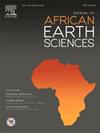A review of the geological setting and economic potential of uranium occurrences in the proterozoic part of the Reguibat Shield of the west African Craton, in northern Mauritania
IF 2.2
4区 地球科学
Q2 GEOSCIENCES, MULTIDISCIPLINARY
引用次数: 0
Abstract
Uranium mineralisation is formed in a wide range of geological settings, including deep magmatic to surficial conditions, and ranges in age from Archean to recent. The success of exploration planning and the choice of efficient extraction methods in an environmentally sustainable manner depend clearly on the understanding of the uranium genesis model and the detailed knowledge of the mineralogy of the deposit.
Mauritania hosts eighty known uranium occurrences, mainly located in the oriental part of the Reguibat Shield. Some of these occurrences have been evaluated with the publication of estimated resources, and even exploratory mining works have been performed on some of them. However, the detailed genetic conditions prevailing for the genesis of most of these occurrences remain poorly studied. Exploration reports indicate that uranium mineralisation in the Reguibat Shield mainly occurs as high temperature deposits hosted by shear zones in granites (hydrothermal Na-metasomatic deposits) and low temperature deposits hosted by calcretes (Calcrete deposits), which form more than 70% of these occurrences.
This paper focuses on the dominant uranium mineralisation systems (uraniferous calcretes and Na-metasomatite) of the oriental part of the Reguibat Shield and, to a lesser extent, other types of uranium deposits. Na-metasomatites are mainly originating from Neobirimian granite and basic rocks and occur through hydrothermal fluids, inducing regional metasomatism along NNW–SSE trending shear zones. While uraniferous calcretes in the area are found as subsurface layers covering a Proterozoic basement made of granitoid and associated gabbro-diorite massifs intersected by a network of mafic dykes. The uraniferous calcretes result from the weathering of the Neobirimian (Paleoproterozoic) granitic basement. Carbonate and uranium minerals (carnotite and tyuyamunite) crystallize as cementation materials within the granite arena. Two types of Neobirimian granites have been identified: the first one being an orientated coarse-grained porphyritic brown to pink granite, while the second one is a porphyritic grey medium-grained granite, whose mineralogy is mostly made up of plagioclase, K-feldspar, quartz, and chloritized biotite, while magnetite, apatite, titanite, zircon, uranothorite, and monazite are the accessory minerals.
毛里塔尼亚北部西非克拉通雷吉巴特地盾原生代部分铀矿的地质环境和经济潜力综述
铀矿化形成于广泛的地质环境中,包括从深层岩浆到表层条件,其年龄从阿寒纪到新近不等。勘探规划的成功和以环境可持续方式高效开采方法的选择显然取决于对铀成因模型的理解和对矿床矿物学的详细了解。毛里塔尼亚拥有八十个已知铀矿点,主要位于雷吉巴特地盾的东部。毛里塔尼亚拥有八十个已知铀矿点,主要位于雷吉巴特地盾的东方部分。对其中一些矿点进行了评估,公布了估计资源量,甚至对其中一些矿点进行了勘探开采。然而,对大多数这些矿点的详细成因条件的研究仍然很少。勘探报告显示,雷吉巴特地盾中的铀矿化主要以花岗岩剪切带寄存的高温矿床(热液钠-金属母岩矿床)和钙质岩寄存的低温矿床(钙质岩矿床)的形式出现,占这些矿点的 70% 以上。本文重点介绍雷吉巴特地盾东部地区的主要铀矿化系统(含铀钙质岩和钠-金属母岩),其次是其他类型的铀矿床。鈉鎂礦主要源自新比利時花崗岩和基性岩,通過熱液流動,沿西北-西南走向剪切帶形成區域變質作用。该地区的含铀岩浆岩是覆盖在新生代基底上的地下岩层,基底由花岗岩和相关的辉长岩-闪长岩岩块组成,并与黑云母岩堤网络相交。含铀钙质岩是由新毕里米世(古新生代)花岗岩基底风化而成。碳酸盐和铀矿物(钙钛矿和 tyuyamunite)作为胶结材料在花岗岩岩场内结晶。目前已发现两种类型的新比利姆花岗岩:第一种是定向粗粒斑状褐色至粉红色花岗岩,第二种是斑状灰色中粒花岗岩,其矿物主要由斜长石、K长石、石英和绿帘石组成,而磁铁矿、磷灰石、榍石、锆石、铀钍石和独居石则是附属矿物。
本文章由计算机程序翻译,如有差异,请以英文原文为准。
求助全文
约1分钟内获得全文
求助全文
来源期刊

Journal of African Earth Sciences
地学-地球科学综合
CiteScore
4.70
自引率
4.30%
发文量
240
审稿时长
12 months
期刊介绍:
The Journal of African Earth Sciences sees itself as the prime geological journal for all aspects of the Earth Sciences about the African plate. Papers dealing with peripheral areas are welcome if they demonstrate a tight link with Africa.
The Journal publishes high quality, peer-reviewed scientific papers. It is devoted primarily to research papers but short communications relating to new developments of broad interest, reviews and book reviews will also be considered. Papers must have international appeal and should present work of more regional than local significance and dealing with well identified and justified scientific questions. Specialised technical papers, analytical or exploration reports must be avoided. Papers on applied geology should preferably be linked to such core disciplines and must be addressed to a more general geoscientific audience.
 求助内容:
求助内容: 应助结果提醒方式:
应助结果提醒方式:


